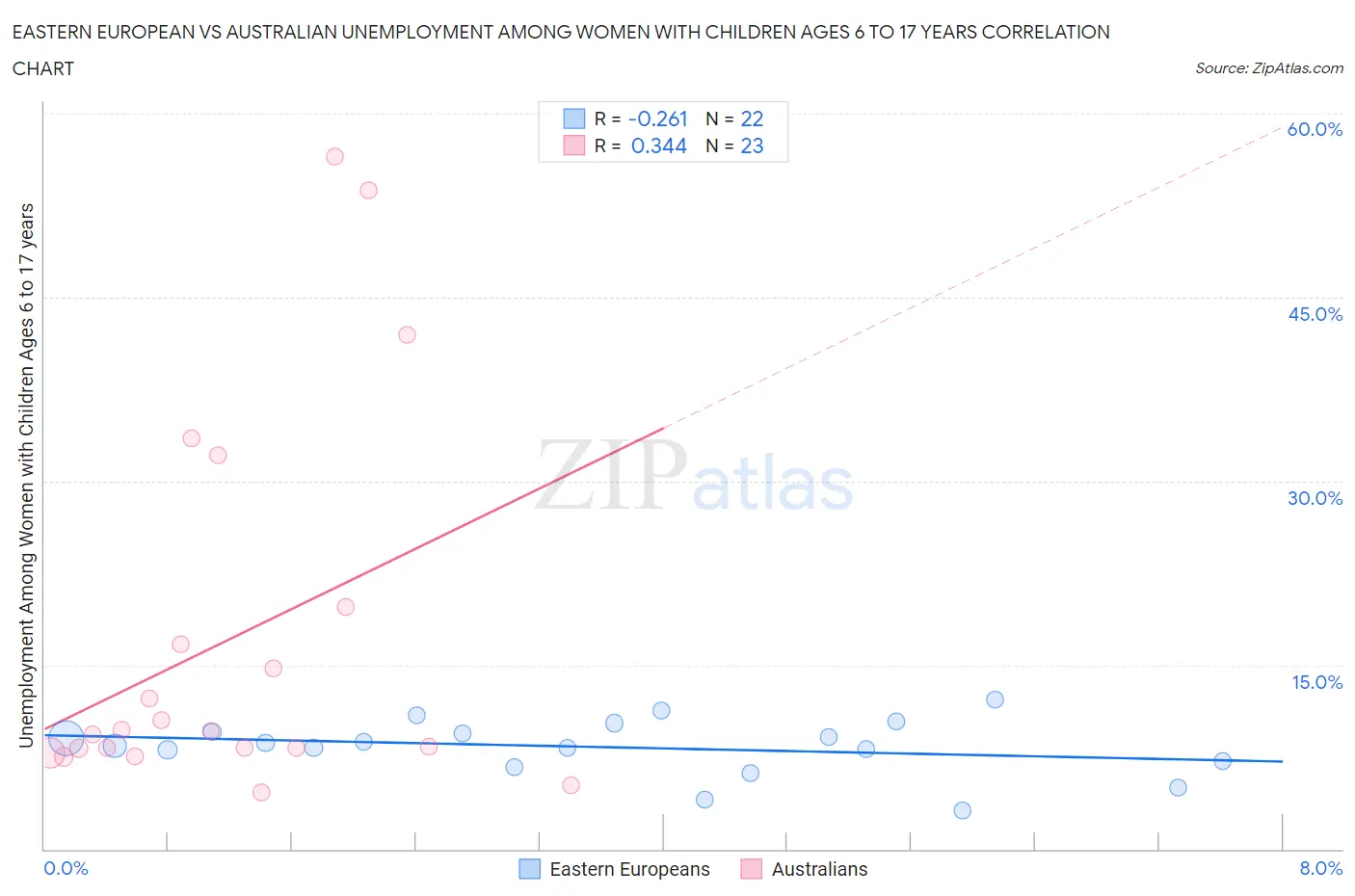Eastern European vs Australian Unemployment Among Women with Children Ages 6 to 17 years
COMPARE
Eastern European
Australian
Unemployment Among Women with Children Ages 6 to 17 years
Unemployment Among Women with Children Ages 6 to 17 years Comparison
Eastern Europeans
Australians
8.6%
UNEMPLOYMENT AMONG WOMEN WITH CHILDREN AGES 6 TO 17 YEARS
96.8/ 100
METRIC RATING
113th/ 347
METRIC RANK
8.5%
UNEMPLOYMENT AMONG WOMEN WITH CHILDREN AGES 6 TO 17 YEARS
98.9/ 100
METRIC RATING
93rd/ 347
METRIC RANK
Eastern European vs Australian Unemployment Among Women with Children Ages 6 to 17 years Correlation Chart
The statistical analysis conducted on geographies consisting of 307,747,219 people shows a weak negative correlation between the proportion of Eastern Europeans and unemployment rate among women with children between the ages 6 and 17 in the United States with a correlation coefficient (R) of -0.261 and weighted average of 8.6%. Similarly, the statistical analysis conducted on geographies consisting of 174,001,217 people shows a mild positive correlation between the proportion of Australians and unemployment rate among women with children between the ages 6 and 17 in the United States with a correlation coefficient (R) of 0.344 and weighted average of 8.5%, a difference of 1.3%.

Unemployment Among Women with Children Ages 6 to 17 years Correlation Summary
| Measurement | Eastern European | Australian |
| Minimum | 3.2% | 4.6% |
| Maximum | 12.2% | 56.5% |
| Range | 9.0% | 51.9% |
| Mean | 8.3% | 17.1% |
| Median | 8.5% | 9.6% |
| Interquartile 25% (IQ1) | 7.2% | 8.2% |
| Interquartile 75% (IQ3) | 9.6% | 19.7% |
| Interquartile Range (IQR) | 2.4% | 11.5% |
| Standard Deviation (Sample) | 2.3% | 15.4% |
| Standard Deviation (Population) | 2.2% | 15.0% |
Demographics Similar to Eastern Europeans and Australians by Unemployment Among Women with Children Ages 6 to 17 years
In terms of unemployment among women with children ages 6 to 17 years, the demographic groups most similar to Eastern Europeans are Romanian (8.6%, a difference of 0.15%), Immigrants from Ukraine (8.6%, a difference of 0.27%), Latvian (8.6%, a difference of 0.28%), Immigrants from Romania (8.6%, a difference of 0.29%), and Swedish (8.6%, a difference of 0.36%). Similarly, the demographic groups most similar to Australians are Immigrants from Barbados (8.5%, a difference of 0.11%), Sri Lankan (8.5%, a difference of 0.16%), German Russian (8.5%, a difference of 0.23%), Bolivian (8.5%, a difference of 0.31%), and Malaysian (8.6%, a difference of 0.36%).
| Demographics | Rating | Rank | Unemployment Among Women with Children Ages 6 to 17 years |
| Australians | 98.9 /100 | #93 | Exceptional 8.5% |
| Immigrants | Barbados | 98.8 /100 | #94 | Exceptional 8.5% |
| Sri Lankans | 98.7 /100 | #95 | Exceptional 8.5% |
| German Russians | 98.6 /100 | #96 | Exceptional 8.5% |
| Bolivians | 98.5 /100 | #97 | Exceptional 8.5% |
| Malaysians | 98.5 /100 | #98 | Exceptional 8.6% |
| Immigrants | Lithuania | 98.4 /100 | #99 | Exceptional 8.6% |
| New Zealanders | 98.4 /100 | #100 | Exceptional 8.6% |
| Immigrants | Pakistan | 98.4 /100 | #101 | Exceptional 8.6% |
| Immigrants | South Africa | 98.3 /100 | #102 | Exceptional 8.6% |
| Scandinavians | 98.3 /100 | #103 | Exceptional 8.6% |
| Immigrants | France | 98.0 /100 | #104 | Exceptional 8.6% |
| Immigrants | Norway | 97.8 /100 | #105 | Exceptional 8.6% |
| Immigrants | Serbia | 97.7 /100 | #106 | Exceptional 8.6% |
| Chickasaw | 97.6 /100 | #107 | Exceptional 8.6% |
| Swedes | 97.6 /100 | #108 | Exceptional 8.6% |
| Immigrants | Romania | 97.5 /100 | #109 | Exceptional 8.6% |
| Latvians | 97.4 /100 | #110 | Exceptional 8.6% |
| Immigrants | Ukraine | 97.4 /100 | #111 | Exceptional 8.6% |
| Romanians | 97.1 /100 | #112 | Exceptional 8.6% |
| Eastern Europeans | 96.8 /100 | #113 | Exceptional 8.6% |